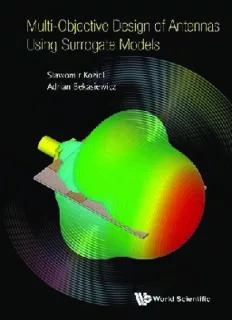Table Of ContentWorld Scientific
Published by
World Scientiic Publishing Europe Ltd.
57 Shelton Street, Covent Garden, London WC2H 9HE
Head oice: 5 Toh Tuck Link, Singapore 596224
USA oice: 27 Warren Street, Suite 401-402, Hackensack, NJ 07601
Library of Congress Cataloging-in-Publication Data
Names: Koziel, Slawomir, author. | Bekasiewicz, Adrian author.
Title: Multi-objective design of antennas using surrogate models / Slawomir Koziel
(Reykjavik University, Iceland) & Adrian Bekasiewicz (Reykjavik University, Iceland).
Description: [Hackensack] New Jersey : World Scientiic, [2016] |
Includes bibliographical references.
Identiiers: LCCN 2016024714 | ISBN 9781786341471 (hc : alk. paper)
Subjects: LCSH: Antennas (Electronics)--Simulation methods. | Antennas
(Electronics)--Mathematical models. | Antennas (Electronics)--
Design and construction. | Multiple criteria decision making.
Classiication: LCC TK7871.6 .K69 2016 | DDC 621.382/4--dc23
LC record available at https://lccn.loc.gov/2016024714
British Library Cataloguing-in-Publication Data
A catalogue record for this book is available from the British Library.
Copyright © 2017 by World Scientiic Publishing Europe Ltd.
All rights reserved. This book, or parts thereof, may not be reproduced in any form or by any means,
electronic or mechanical, including photocopying, recording or any information storage and retrieval
system now known or to be invented, without written permission from the Publisher.
For photocopying of material in this volume, please pay a copying fee through the Copyright Clearance
Center, Inc., 222 Rosewood Drive, Danvers, MA 01923, USA. In this case permission to photocopy
is not required from the publisher.
Desk Editors: Kalpana Bharanikumar/Mary Simpson
Typeset by Stallion Press
Email: [email protected]
Printed in Singapore
To our families: Dorota, Anna Halina, Aleksandra, and Igor.
Preface
Full-wave electromagnetic (EM)-simulation models have become
fundamental tools in the design of contemporary antenna struc-
tures. High-fidelity EM analysis ensures evaluation accuracy but
it might be computationally expensive. Therefore, direct use of
EM-simulations in the design process, especially for parametric
optimization, is normally associated with high computational cost,
often prohibitive. This makes simulation-driven antenna design a
challenging task. An additional difficulty is the necessity of simul-
taneous handling of several, and often conflicting design objec-
tives. If comprehensive information about the best possible trade-
offs between these objectives is to besought, genuine multi-objective
optimization needs to be carried out. The most popular solution
approaches, population-based metaheuristics, are too expensive in
computational terms. Expedited multi-objective design can be real-
ized using surrogate-assisted techniques. This book presents several
waysofutilizingsurrogatemodelingmethods(bothlocalandglobal),
variable-fidelity EM-simulations and design space reduction tech-
niquesfor accelerated antenna designwith respectto several criteria.
The procedures formulated here are demonstrated using numerous
examples of real-world antenna design problems. Furthermore, the
book contains introductory material concerning numerical optimiza-
tion, both conventional (gradient-based and derivative-free, includ-
vii
viii Preface
ing metaheuristics) and surrogate-based, as well as fundamentals of
multi-objectiveoptimization.Recommendationsconcerningpractical
aspects of surrogate-assisted multi-objective antenna optimization
are also given.
Slawomir Koziel and Adrian Bekasiewicz
March 2016, Reykjavik, Iceland
About the Authors
Adrian Bekasiewiczreceived hisM.Sc.degree
in Electronic Engineering from Gdansk Univer-
sity of Technology, Gdansk, Poland, in 2011.
He is currently pursuing his Ph.D. in Wireless
Communication Engineering at Gdansk Univer-
sity of Technology, Gdansk, Poland. He is also
a Research Associate with the School of Science
and Engineering, Reykjavik University, Iceland.
He has authored or co-authored over 150 peer-
reviewed papers. His research interests include multi-objective opti-
mization, metaheuristic algorithms, design of compact microwave
antennas, and miniaturization of microwave/RF components.
Slawomir Kozielreceived hisM.Sc.andPh.D.
degrees in Electronic Engineering from Gdansk
University of Technology, Poland, in 1995 and
2000, respectively. He also received the M.Sc.
degrees in Theoretical Physics and in Mathe-
matics, in 2000 and 2002, respectively, as well
as a Ph.D. in Mathematics in 2003, from the
University of Gdansk, Poland. He is currently a
Professor with the School of Science and Engi-
neering, Reykjavik University, Iceland. His research interests include
CADandmodelingofmicrowaveandantennastructures,simulation-
driven design, surrogate-based optimization, space mapping, cir-
cuit theory, analog signal processing, evolutionary computation and
numerical analysis.
ix
Acknowledgments
We would like to acknowledge the efforts of all those students,
researchers, and colleagues who have helped us during the research
work presented in this book. In particular, we would like to thank
Dr. Stanislav Ogurtsov for inspiring discussions and help with EM
modeling of antenna structures. We would also like to thank Com-
puter Simulation Technology AG, Darmstadt, Germany, for making
CST Microwave Studio available for our research purposes.
xi
Contents
Preface vii
About the Authors ix
Acknowledgments xi
1. Introduction 1
2. Simulation-Driven Antenna Design 9
2.1. Simulation-Driven Design of Antenna Structures . . 9
2.2. Computational Models . . . . . . . . . . . . . . . . . 16
2.3. Challenges of Contemporary Antenna Design . . . . 24
3. Introduction to Numerical Optimization 27
3.1. Optimization Problem Formulation . . . . . . . . . . 28
3.2. Gradient-Based Optimization Techniques . . . . . . 29
3.2.1. Gradient-Based Optimization
Using Descent Methods . . . . . . . . . . . . 30
3.2.2. Newton and Quasi-Newton Methods . . . . . 33
3.2.3. Remarks on Constrained Optimization . . . 36
3.3. Derivative-Free Optimization . . . . . . . . . . . . . 40
3.3.1. Pattern Search . . . . . . . . . . . . . . . . . 41
3.3.2. Nelder–Mead Algorithm . . . . . . . . . . . 42
3.4. Summary . . . . . . . . . . . . . . . . . . . . . . . . 45
xiii
Description:This book addresses computationally-efficient multi-objective optimization of antenna structures using variable-fidelity electromagnetic simulations, surrogate modeling techniques, and design space reduction methods. Based on contemporary research, it formulates multi-objective design tasks, highlig

